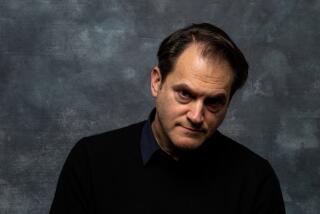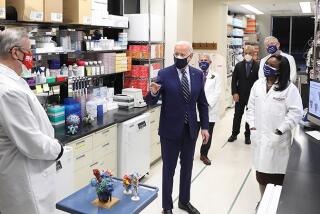Roche Group Returns to Its Roots
- Share via
Century-old Swiss drug giant Roche Group, the parent of Hoffmann-La Roche, is returning to its roots and, potentially, its glory days.
Early on, the Basel-based pharmaceutical company made a variety of novel drugs aimed at the masses, from painkillers and sleep aids to heart drugs, antibiotics and breakthrough anxiety drugs such as Valium.
Over the last decade or two, its focus switched to specialty drugs with smaller markets -- ones used mainly in hospitals or prescribed by specialists in cancer, dermatology, organ transplants, AIDS and hepatitis. Few of its products are household names because Roche doesn’t plaster consumer ads all over TV and newspapers. And it doesn’t rush to copycat competitors’ successes.
That strategy worked well until the late 1990s, when crucial drugs failed in late testing or were commercial flops. In 1999, the company and other drug makers were hit with criminal fines and paid to settle charges that they colluded to inflate wholesale prices that hundreds of food and beverage companies paid for vitamins added to their products. Then its huge investment portfolio, which generated about one-fourth of revenue in 2000, began losing money as world markets plunged.
“This used to be one of the premier pharmaceutical companies in the world,” said Hemant Shah, an independent pharmaceutical analyst at HKS & Co. in Warren, N.J. “Then they kind of stumbled.”
Now Roche, which announces its midyear financial results Wednesday, is returning to its old strategy. The key drugs in its pipeline are for conditions afflicting millions, including asthma, depression, osteoporosis, diabetes and stress incontinence, or bladder leakage triggered by exercise, coughing or laughing.
Roche is banking on those new drugs’ working better, with fewer side effects, than existing ones because they directly target enzymes or mechanisms causing the condition, said Louis Renzetti, who heads Hoffmann-La Roche’s efforts to speed up discovery of new compounds.
Roche has nearly 200 potential drugs in development, a third of them based on new chemical compounds, said George Abercrombie, chief executive at Hoffmann-La Roche, the company’s U.S. pharmaceuticals business.
When he arrived in 2001, sales and other staff had been built up well beyond what annual revenue -- now $21 billion a year -- could support, given the unexpectedly low sales of influenza treatment Tamiflu and weight-loss drug Xenical. He slashed the U.S. workforce 25%.
Roche made other key management changes, got the global staff down to the right size and made some good acquisitions and deals to license rights to other companies’ experimental drugs, said Alistair Campbell, pharmaceuticals analyst at Smith Barney in London. Roche also is selling its vitamin and chemicals business, putting behind it a scandal that has cost more than $3.5 billion.
A stock slide since 1999, from about $130 per share to a low of about $56 last March, finally ended. Shares are now up about 40% to the $80 range, and some institutional investors recommend buying the stock.
“After a few difficult years, we believe Roche offers a turnaround in its pharmaceuticals business,” J.P. Morgan analyst Premal Pajwani wrote this year. That turnaround has been driven by its two newest drugs -- Fuzeon for AIDS and Pegasys, an advanced hepatitis C treatment -- and by products from its biotech subsidiary Genentech Inc. in San Francisco.
“However, the road to resurrection will be rocky,” Pajwani added. He cited upcoming patent expirations for the acne drug Accutane and injectable antibiotic Rocephin.
While seven Roche drugs now lead their categories, none are among the top 20 in sales in the U.S., the world’s biggest market. But Genentech’s cancer drugs Herceptin and Rituxan are big sellers. And Fuzeon and Pegasys could be major moneymakers.
Founded in 1896 by Fritz Hoffmann and wife Adele La Roche and initially named for the couple, the company that was eventually renamed the Roche Group initially manufactured an antiseptic, a painkiller and a heart drug, before establishing a division to research new compounds in 1910. That was incorporated as Hoffmann-La Roche in 1929.
Roche, which is still controlled by descendants of the founding family, initiated the “vitamin era” in the 1930s by figuring out how to make synthetic vitamins in bulk and long dominated that field. Hoffmann-La Roche chemist Leo Sternbach’s discovery of the anti-anxiety drug Valium, which became a cultural icon and Roche’s first blockbuster soon after its 1963 introduction, launched a golden era for Roche.
Over the next few decades, it created a division that makes diagnostic tests and rolled out major drugs. They include Dalmane for insomnia, the antibiotics Bactrim and Rocephin, Accutane for severe acne, blockbuster ulcer drug Zantac, painkiller Toradol and the sedative Versed.






